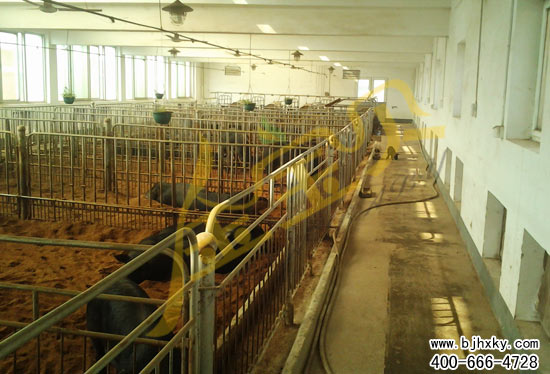The Regulations on Prevention and Control of the Pollution of Livestock and Poultry Scale Production has been in effect since January 1, 2014. For a long time, there has been widespread misunderstanding that the strengthening of environmental protection supervision for livestock and poultry requires farmers to build environmental protection facilities and achieve discharge of pollutants that meet the standards. Larger initial investment and unsatisfactory operating expenses are required, and livestock and poultry farmers will be taken with them. Heavier economic burdens have hindered the development of livestock and poultry husbandry. Therefore, many people are worried about the environmental protection of livestock and poultry breeding, and even there is resistance. In fact, it is not impossible to achieve a win-win situation between environmental protection and industrial development. The use of jinbao dry-leaf-fermentation aquaculture technology allows the two to complement each other, support each other and promote each other, and promote the industry while improving the level of environmental protection. Healthy development and achieving a win-win situation. Based on the principles of microbiology and ecology, the use of microbes as a “central†role in the circulation and conversion of the material energy of the Jinbao Dry Sausage Fermenting Bed will allow fermentation bed strains to be mixed with sawdust, rice bran, and peanut shells in a certain ratio. Into organic composite litter, shop 50 cm thick in the pen home, put the pig into bed to start the fermentation after pulling excrement, can meet the pigs on the temperature, micro ecology, ventilation and other physiological needs. It uses the pig's arching habits to fully mix pig manure urine and litter, and after decomposition and fermentation, the organic matter of pig manure is fully decomposed and transformed. Microbes use the undigested swine feces as bait to reproduce and breed, and to remove odors. At the same time, a large number of microbes that reproduce and grow provide pigs with foods such as bacterial proteins, which make the pig houses evolve into feed factories and manure treatment plants. An ecological chain, so as to achieve the effects of fly-free, odor-free, pollution-free, and zero-emission in pig breeding, so that the pigs are returned to the natural environment. First, prepare padding material such as sawdust or rice husk, and then mix and dilute the gems dry fermented bed strain at a ratio of 1:5 with rice bran or wheat bran, and then dilute the well-prepared bacteria and prepared pad. The material is mixed evenly. In order to achieve a uniform effect, a multi-stage dilution method can also be adopted. Alternatively, the first layer of the sawdust mixture of the husk sawdust can be about 10 cm, and then evenly spread into the fermentation bed diluted with rice bran, and then laid on 10 cm. The mixture of rice husk sawdust was then sprinkled into the fermentation bed strain. A total of five layers of padding and five layers of bacteria were spread until the thickness of the padding reached 40 to 50 cm. After laying the bed, the pig can be put in for feeding. The cost of ginba dry-type fermentation bed mainly includes litter cost and strain cost. The cost of strains and litter varies depending on the market and region. Of course, there are also labor and other expenses. Goldbeet fermentation bed is one dose and one material is simple to operate. , to maximize savings in personnel costs and accessories costs. Take 20 squares of pigs in the fermentation bed as an example: Sawdust padding costs: 0.5 meters x 20 squares x 40 yuan/cubic (sawdust is 40 yuan/cube) = 400 yuan. The cost of strains is 20 yuan per square meter (13 cubic meters of fermented bed per kilogram of fermenter), 20 square meters requires about 400 yuan, and the total cost is 800 yuan, and the fermentation bed is a one-off investment for many years, spread to each pig. The cost is 800/(15 heads × 3~4 batches/year) = 13 yuan, and this is only a single lap, the cost of strains and litters will be reduced when used in large quantities, plus the use of pigs in the fermentation bed Provincial feed costs, medical expenses, water fees, electricity bills, cleaning up of faeces, etc. will bring higher aquaculture benefits. Recommended reading 2. Environmental problems and control measures for livestock and poultry husbandry Instant Breakfast,Black Tartary Buckwheat Breakfast Powder,Nutritious Buckwheat Powder, Oatmeal Sesame Buckwheat Powder Huantai Biotechnology Co., Ltd. , https://www.huantaifds.com
To sum up, the technology of Jinbao Dry Sausage Fermenting Bed has not only simple operation and low cost, but also solves the problem of environmental pollution caused by livestock and poultry breeding at the source. The national government also provides subsidy for ecological farming technology and gives it to the farmers. Households solve the problem of national aquaculture pollution regulations. For details, please contact: Beijing Huaxia Kangyuan Technology Co., Ltd. Telephone toll-free hotline factory Taobao shop to purchase fermentation bed bacteria please click: http://item.taobao.com/item.htm?spm=a1z10.1.w4004-4533113354.9.pPHXQH&id=13380184754
1. "Healthy Breeding" begins with the use of a dry-sparing fermentation bed
Fermentation Bed Breeding to Farmers in Response to National Farming Pollution Regulations
Next Article
The efficacy of white mustard
Prev Article
The use of plant-derived pesticides